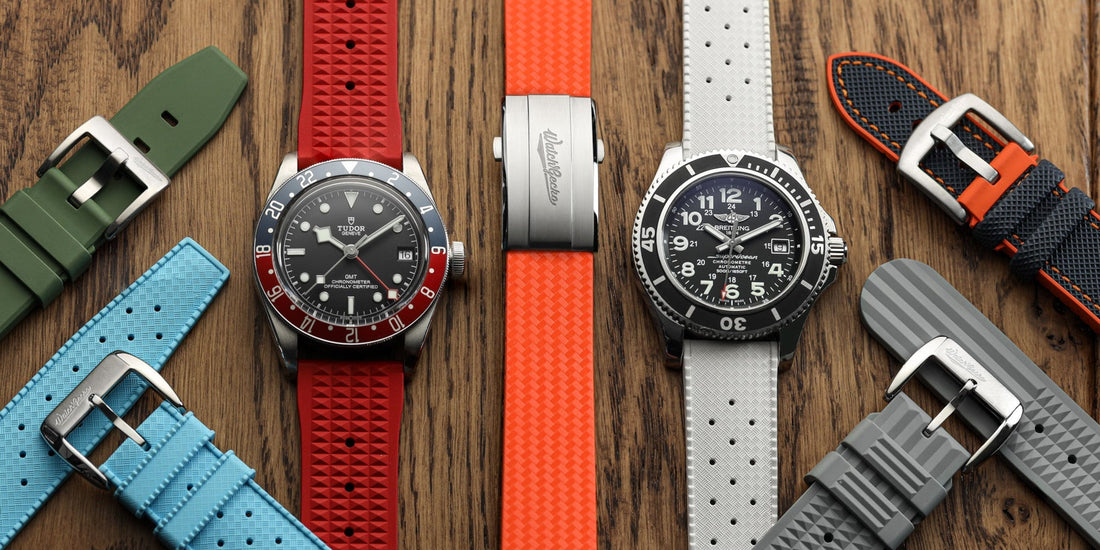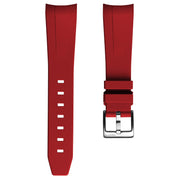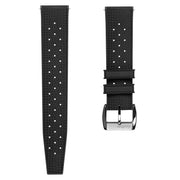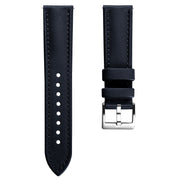Of all the materials available for watch straps today, rubber — whether natural or synthetic — has come a long way. Once considered sticky, stiff, and uninspired, rubber watch straps have now claimed their place as stylish, durable, and downright cool accessories for everything from vintage divers to luxury sports watches.
In this guide, we’re diving into the history, benefits, and different types of rubber watch straps, helping you decide which one’s right for your wrist.
Rubber Watch Straps – A Brief History

Rubber watch straps first gained real traction in the 1960s, especially among divers. Ads from the era (including gems found in Marco Strazzi’s Watch Ads 1960–2000) show rubber as a practical but far-from-luxurious option. Many early rubber straps didn’t age well — they’d crack, stick to your skin, and rarely looked like they belonged anywhere near a dress shirt.
But there were exceptions. Swiss-made Tropic straps, for instance, became a cult favourite. Designed as a practical and affordable alternative to metal bracelets, they were issued on iconic dive watches from Rolex, Tudor, and Blancpain — even the original IWC Aquatimer. Vintage French tool watches and super-compressor cased models often came fitted with Tropic straps as standard.
Through the ‘70s and ‘80s, brands like Precimax, Aquastar, and Glycine embraced rubber. By the 1990s, high-end names like IKEPOD and Audemars Piguet had also joined in, solidifying rubber’s place in the luxury world. Perhaps the biggest milestone came in the 1980s, when Hublot introduced rubber straps on its luxury timepieces — a bold move that redefined what a rubber strap could be.
Italian Innovation and Modern Performance
The rise in rubber strap quality owes much to Italian manufacturer Bonetto Cinturini, who emerged as a major player in the 1980s. Today, they’re one of the most respected names in the game, producing straps for Swiss luxury brands and microbrands alike. Whether you’re after a stealthy black strap with a tyre tread texture or a bold orange band that demands attention, Bonetto has something to suit your style.
Modern rubber straps aren’t just for diving anymore. From Breitling’s Superocean Heritage to Chopard’s Mille Miglia chronographs — which famously mimic vintage Dunlop tyre treads — rubber straps are now synonymous with performance and style.

What Kind of Rubber Is Best for Watch Straps?
You don’t need a degree in polymer chemistry to pick a strap, but it helps to know the basics. Not all rubber is created equal, and your experience can vary dramatically depending on the material.
Natural Rubber
Once plagued by stickiness and cracking, natural rubber straps today are usually vulcanised for better strength and flexibility. Nitrile Butadiene Rubber (NBR) is a standout — soft, durable, and resistant to everything from sweat to seawater.
HNBR (Hydrogenated Nitrile Butadiene Rubber)
A step up from standard NBR, HNBR is produced by hydrogenating the rubber’s polymer chains — essentially adding hydrogen to improve its stability and performance. The result is a tougher, more resilient material with higher temperature resistance, improved chemical resistance, and better protection against wear and oxidation. It’s also free from PFAS chemicals, which is increasingly important for eco-conscious customers. We’re seeing more demand for HNBR straps from people who want long-term durability without compromising on safety or comfort — and we’re proud to say many of our rubber straps now use this advanced material.
Silicone
Silicone is often chosen for fashion straps thanks to its soft texture and colour options. But it’s not perfect — it attracts dust, can tear more easily than other rubbers, and sometimes feels too stretchy. Some brands like Sinn still make great use of it, but for hard-wearing purposes, it's not always first choice.
PU (Polyurethane)
Polyurethane straps are tough, elastic, and often very functional. They can feel slightly firmer than natural rubber but tend to last ages. They’re ideal if you’re wearing your watch in harsher environments.
PVC
Polyvinyl Chloride is extremely durable and tends to have a shinier finish. It’s less common for high-end watch straps today, as it lacks the flexibility and comfort of NBR or silicone, but still does the job on budget-friendly options.
FKM (Fluoroelastomer)
FKM is the premium option. Resistant to heat, chemicals, and wear, it’s the material behind some of the most durable and luxurious rubber straps on the market. It’s what brands like Rolex use in their Oysterflex "technical bracelet" — just don’t call it a strap.
Isoprene and Neoprene
Isoprene has its fans too. It mimics the feel of natural rubber but offers even greater durability. Neoprene, meanwhile, is more often used in wet suits but occasionally makes an appearance in specialist straps.
What Are the Benefits of Rubber Watch Straps?


Rubber watch straps have some clear advantages, especially if you lead an active lifestyle:
- Waterproof: Perfect for diving, swimming, or even just a sweaty gym session.
- Comfortable: Good rubber conforms to your wrist and moves with you.
- Durable: Resistant to UV, saltwater, and extreme temperatures.
- Stylish: From classic Tropic-style textures to minimalist silhouettes in bold colours, rubber offers more versatility than ever.
- Lightweight: A welcome break from chunky bracelets.
- Affordable: Unless you’re buying from a luxury brand, rubber straps are generally excellent value.
- Low maintenance: Easy to clean with a quick rinse.
- Non-allergenic: Ideal if you have sensitive skin or allergies.
- Vanilla-scented: Yes, that’s a thing — and Bonetto Cinturini does it best.
Which Rubber Watch Strap is Right for You?

As ever with watches and watch accessories, choosing between different types of watch straps involves several variables. Whether you eventually go for natural NBR rubber or a synthetic polymer like PU or silicone, your strap choice will reflect how you’ll use it and your personal preferences. Fancy bright colours and a ‘cheap and cheerful’ strap for occasional wear? Then a silicone band might do the job. But if you’re after long-term comfort and durability — especially for diving or daily wear — we’d point you toward an Italian HNBR strap or another high-quality option made for performance.
Modern deployant rubber straps also offer the sleekness of a bracelet with the comfort of rubber — perfect for dressier divers and sport watches. And if you like to change up your look often, the affordability of quality rubber straps makes it easy to build a small collection.
Not sure where to start? Head over to our A–Z Rubber Strap Guide for a complete breakdown of the different styles we offer, from Tropic and waffle patterns to curved-end designs and deployant rubber options. You can also browse our Strap Showcases for inspiration and real-world pairings to help find the perfect strap for your watch and lifestyle.
So, What’s It Going to Be?
The rubber strap has gone from a functional tool to a design statement. Whether you want something colourful, minimalist, vintage-inspired or just plain tough, rubber has never looked better — or lasted longer.
At WatchGecko, we’re proud to offer a curated range of high-quality rubber straps that fit seamlessly into today’s watch culture. From Italian-made options to modern silhouettes inspired by decades of design history, there’s never been a better time to get into rubber.
So what’s it going to be — a bold orange number for your beach watch, a classic black Tropic for your vintage diver, or a modern deployant strap for your everyday wear? Whichever way you go, rubber’s got your back (and your wrist).











